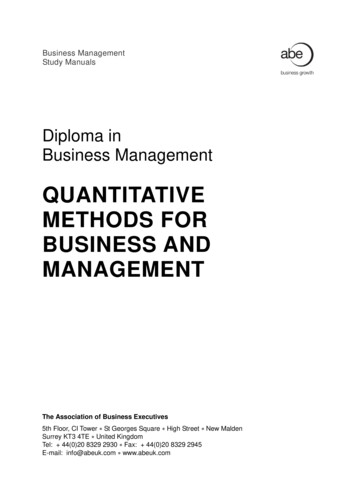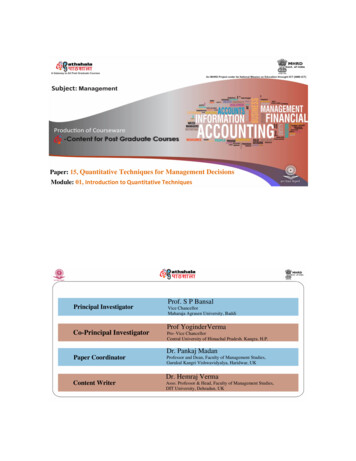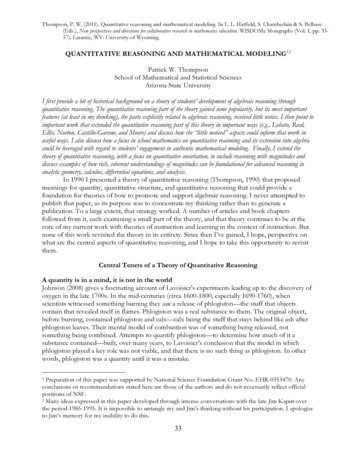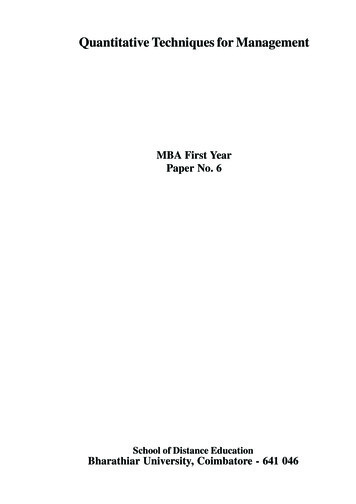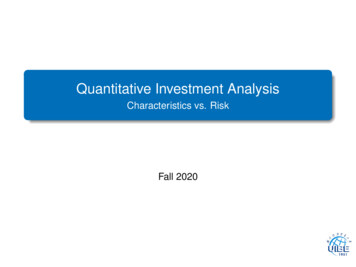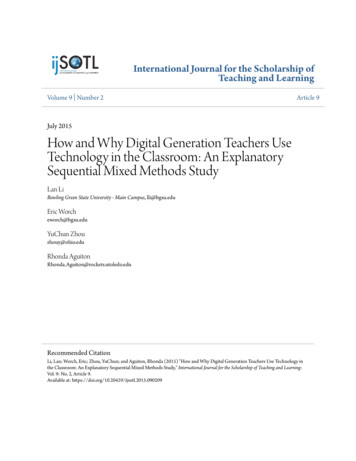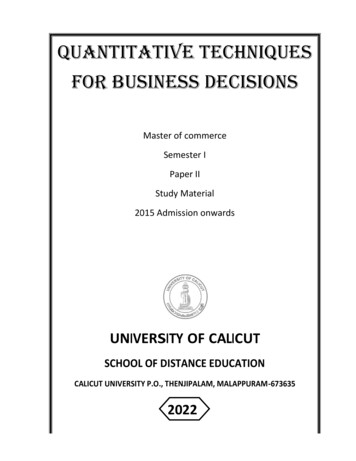
Transcription
QUANTITATIVE TECHNIQUESFOR BUSINESS DECISIONSMaster of commerceSemester IPaper IIStudy Material2015 Admission onwardsUNIVERSITY OF CALICUTSCHOOL OF DISTANCE EDUCATIONCALICUT UNIVERSITY P.O., THENJIPALAM, MALAPPURAM-6736352022
School of Distance EducationUNIVERSITY OF CALICUTSCHOOL OF DISTANCE EDUCATIONMaster of commerceStudy Material2015 Admission onwardsSemester IPaper IIQUANTITATIVE TECHNIQUES FOR BUSINESS DECISIONSPrepared byDr. Yakoob . c.Reader and Research Guide,SS COLLEGE, AREACODE.Type settings and Lay out :Computer Section, SDE ReservedQuantitative Techniques for Business DecisionsPage 2
School of Distance EducationTABLE OF CONTENTNo.TopicPage No.123QUANTITATIVE TECHNIQUES - CONCEPTS45SAMPLING & SAMPLE SIZE67PARAMETRIC TESTS – MEANS & PROPORTIONSTESTS FOR VARIANCE & PAIRED OBSERVATIONS324589ANALYSIS OF VARIANCENON P[ARAMETRIC TESTS - CONCEPTS515910CHI-SQUARE TESTS651112SIGN AND SIGNED RANK TESTS73841314STATISTICAL QUALITY CONTROL - CONCEPTSCONTROL CHART FOR VARIABLES9310015CONTROL CHART FOR ATTRIBUTES1071617TOTAL QUALITY MANAGEMENTCORRELATION ANALYSIS11612218RANL, PARTIAL & MULTIPLE CORRELATION13119REGRESSION ANALYSIS1372021SOFTWARES FOR QUANTITATIVE ANALYSISAPPENDIX147160INFERENTIAL ANALYSIS- POINT ESTIMATIONINTERVAL ESTIMATIONTESTS OF SIGNIFICANCE - CONEPTSRANK SUM & OTHER NON PAREMETRIC TESTSQuantitative Techniques for Business Decisions513192327Page 3
School of Distance EducationQuantitative Techniques for Business DecisionsPage 4
School of Distance EducationUNIT 1QUANTITATIVE TECHNIQUES FOR MANAGERIAL DECISIONSIntroductionDecision making is the most complex, but essential human activity. Several tools havebeen developed for facilitating decision making – whether in ordinary course of life or business.Good decisions are always applauded. Decisions determine the destiny of individuals ororganizations.Decisions can be based on both qualitative aspects and quantitative data. Certainsituations warrant the introduction of elements of quantities which support judgment andintuition. Many of the decision circumstances of business organizations necessitate planning andevaluation of alternatives. Thus emerged the subject of quantitative techniques.Business is becoming more and more complex and requires effective management tosucceed. Managing complexity requires many professional skills including quantitative analysis.Business environment is being globalized, competitors are increasing, demand is getting diverse,and employees becoming more mobile and demanding. As a consequence, effective decisionmaking is more crucial than ever before.On the other hand, managers have more access to larger and more detailed data basethat are potential sources of information. However, to achieve this potential, it is required thatmanagers know how to convert data into information. This is one of the reasons why quantitativetechniques are being more and more focused.DefinitionsSince Quantitative technique is a practical methodological technique, there is no precisedefinition for the term. Quantitative techniques are defined as “those statistical techniqueswhich lead to numerical analysis of variables, affecting a decision situation, and evaluation ofalternative strategies to attain objectives of organizations.”Quantitative techniques involves “ transformation of a qualitative description of adecision situation, into quantitative format, identifying of variables, setting out alternativesolutions and supplementing decision making, by replacing judgment and intuition.”Quantitative techniques may be described as those techniques “which provide decisionmaker, with a systematic and powerful tool of analysis, based on quantitative and numeric datarelating to alternative option.”Thus quantitative techniques are a set of techniques involving numerical formulation of adecision situation and analysis of variables, so as to arrive at alternative solutions, leading tooptimal decision.Meaning and NatureQuantitative techniques comprise those statistical and programming techniques which arehelpful in managerial decision making. These techniques involve use of numbers, symbols andother mathematical expressions to express problems in quantitative terms. They serve as a usefulsupplement to human judgment and intuition. They prove a systematic means of analysis andchoice for attaining predetermined objectives of an organization. Quantitative techniques involveuse of scientific methods of experimentation, observation and modification, in managerialdecision making process.Quantitative Techniques for Business DecisionsPage 5
FeaturesSchool of Distance EducationDescriptions of quantitative techniques reveal following characteristics or features.MeasurementMeasurement is the basis of quantitative technique. Measurement is assigning numbersto concepts and phenomena. Measurement generates necessary data.Numerical analysisAnother basic feature of quantitative techniques is numerical expression of variables andanalysis thereto. Even qualitative characteristics or phenomenon can be transformed to numbersand symbols using quantitative techniques.Scientific methodQuantitative techniques for decision making are examples for the use of scientificmethods of management. It offers a systematic and objective experimentation, observation andevaluation of best strategies.Decision makingIt is a support system in decision making process. It provides decision makers withappropriate tools of evaluation and presentation.OptionsQuantitative techniques should evaluate and reveal alternative strategies or options.There is no scope for decision where there is a single option.ImprovementQuantitative techniques should replace personal judgment and intuition. It should lead toimproved and quality decisions.Functions of quantitative techniquesQuantitative Techniques are those methods in which details of a problem or situation areexpressed in numerical terms, so as to support decision making. Accordingly, following are thefunctions of Quantitative techniquesQuantificationCritical factors affecting a decision situation is transformed into quantitative or numericalform. It is easy to comprehend, understand and delegate an issue in numerical form.AnalysisQuantitative techniques enable scientific and systematic study of any issue. It probes deepinto the factors influencing the problem and helps to express the situation in a comprehensiveform.Decision makingQuantitative techniques facilitate the process of decision making. It sets out all possiblealternatives and enables a feasibility study of each so that the optimal alternative can be chosenDeployment of resourcesQuantitative techniques, if properly applied, leads to optimal allocation of availablelimited resources. It avoids wastages and less efficient usage of resources, and leads toconservation of resources.Quantitative Techniques for Business DecisionsPage 6
SequencingSchool of Distance EducationCertain projects may involve several complex activities , to be performed in a sequentialorder. Quantitative techniques aids in determining optimal sequence of performing a set of jobs,so as to minimize total process time.Optimize serviceIn service sector, quantitative techniques is the only option for addressing questions likewaiting time, service time, traffic intensity, idle time etc.Role of quantitative techniques in decision makingQuantitative techniques have been increasingly used in decision making relating tosolution of complex problems of business and industry. Quantitative techniques are nowrecognized as an effective tool for solving managerial problems. Its role is vital due to followingreasons,Better controlManagement of bigger organizations find it much costlier to provide continuous executivesupervision over routine decisions. A Quantitative techniques approach directs the executives todevote their attention to more pressing matters. For example quantitative techniques approachdeals with production scheduling and inventory control.Better coordinationSometimes quantitative techniques have been very useful in maintaining the orderlysituation out of chaos. For example, quantitative techniques based planning model becomes avehicle for coordinating possibilities of marketing decisions with the limitations imposed onmanufacturing capabilities.Better systemQuantitative techniques study is also initiated to analyze a particular problem of decisionmaking such as establishing a new warehouse. Later quantitative techniques approach can befurther developed into a system to be employed repeatedly. Consequently the cost ofundertaking the first application may improve the profits.Better decisionsQuantitative techniques models frequently yield actions that do improve an intuitivedecision making. Sometimes a situation may be so complicated that the human mind can neverhope to assimilate all the important factors without the help of quantitative techniques andcomputer analysis.Quantitative and qualitative approachesDecision making is the process of selecting optimal alternative from among severalalternatives, subject to states of nature. While analyzing a situation for such a selection, twoapproaches can be adopted – quantitative approach and qualitative approachQuantitative approachThis approach involves generation and analysis of data in numerical form. Data obtained as per quantitative approach can be subjected to rigorous quantitative analysis in a formal fashion.This will reveal almost all inherent characteristics of the variable under study.Quantitative Techniques for Business DecisionsPage 7
School of Distance EducationQuantitative approach may further be subdivided into inferential, experimental andsimulation approaches. The purpose of inferential approach is to form a data base to infercharacteristics or relationships of variables. Required data would be usually obtained throughfield survey.Experimental approach is characterized by much greater control over the studyenvironment, and in this case variables are manipulated to observe their effect on othervariables.Simulation approach involves the construction of an artificial environment or modelwithin which relevant information and data can be generated. This permits an observation ofdynamic behavior of the system or sub system under modeled conditions. The term simulation, inthe context of business, means building of a model, that represents the structure of a dynamicprocess or operation.Qualitative approachQualitative approach is concerned with subjective assessment of attitudes, opinions andbehavior. Decision making in such situations is a function of decision maker’s insight andimpressions. Such an approach generates results either in non-quantitative form or in a formwhich cannot be subjected to rigorous quantitative analysis. For example, opinion that a personmay be good or badBasically, the techniques of focus group interviews, projective techniques and depthinterviews use qualitative approach for decision making.Generally there are four non quantitative techniques of decision makingIntuition – decision making on intuition is characterized by inner feelings of the decisionmaker. It is purely subjectiveFacts –It follows the rule that decision should be based on facts, and not on feelings.Experiences – Experience is the most valuable asset, if used logically. Decisions should bebased on precedence.Opinion – in decision making, expert opinions can be relied on. In fact, this is widely usedby all levels of managers.However, even qualitative approach may be transformed into quantitative form, inpractical studies. This is achieved through measurement and scaling. Measurement is assigningnumbers or values to concepts or phenomena. Scaling refers to placing a concept orcharacteristic on the appropriate position of a measured scale. For example, Marital status of aperson may be :(single)1 , (married)2, (divorced)3 (widowed)4. Here qualitative or nonquantitative data is logically converted into quantitative data.Significance of quantitative decisionsQuantitative Techniques have proved useful in tackling managerial decision problemsrelating to business and industrial operations. Quantitative decisions are considered significanton the following grounds.Quantitative Techniques for Business DecisionsPage 8
Simplifies decision makingSchool of Distance EducationQuantitative techniques simplify the decision making process. Decision theory enables amanager to select the best course of action. Decision tree technique refines executive judgmentin systematic analysis of the problem, these techniques permit scientific decision making underconditions of risk and uncertainty. Decision problems such as manpower planning ,demandforecasting, selection suppliers, production capacities, and capital requirements planning can bemore effective tackled using quantitative techniques.Scientific analysisIt provides a basis for precise analysis of the cause and effect relationship. They make itpossible to measure the risks inherent, in business by providing an analytical and objectiveapproach. These techniques reduce the need for intuition and objective approach. In this wayquantitative techniques enable managers to use logical thinking in the analysis of organizationalproblems,Allocation of resourcesThey are very helpful in the optimum deployment of resources. For example, ProgrammeEvaluation and Review Techniques enable a manager to determine the earliest and the latesttimes for each of the events and activities involved in a project. The probability of completing theproject by a specified date can be determined. Timely completion of the project helps to avoidtime and cost overruns. Similarly, linear programming technique is very useful in optimalallocation of scarce resources, production scheduling and in deciding optimal assignments.Profit maximizationQuantitative techniques are invaluable in assessing the relative profitability of alternativechoices and identifying the most profitable course of action. What should be the relative mix ofdifferent products, which site to choose for location out of alternative sites, which arrangementof orders in terms of time and quantity, will give maximum profits. Such question can beanswered with the help of quantitative techniques.Cost minimizationQuantitative techniques are helpful in tackling cost minimization problems. For examplewaiting line theory enables a manager to minimize waiting and servicing costs. Their techniqueshelp business managers in taking a correct decision through analysis of feasibility of addingfacilities.ForecastingQuantitative techniques are useful in demand forecasting. They provide a scientific basisof coping with the uncertainties of future demand. Demand forecasts serve as the basis forcapacity planning. Quantitative technique enables a manager to adopt the minimum risk plan.InventorycontrolInventory planning techniques help in deciding when to buy and how much to buy. Itenables management to arrive at appropriate balance between the costs and benefits of holdingstocks. The integrated production models technique is very useful in minimizing costs ofinventory, production and workforce. Statistical quality controls help us to determine whetherthe production process is under control or not.Quantitative Techniques for Business DecisionsPage 9
School of Distance EducationApplications of quantitative techniques in business operationsQuantitative techniques are widely applied for solving decision problems of routineoperations of business organizations. It is especially useful for business managers, economist,statisticians, administrators, technicians and others in the field of business, agriculture, industryservices and defense. It has specific applications in the following functional areas of businessorganizations.PlanningIn planning, quantitative techniques are applied to determine size and location of plant, productdevelopment, factory construction, installation of equipment and machineries etc.PurchasingQuantitative techniques are applied in make or buy decisions, vendor development,vendor rating, purchasing at varying prices, standardization and variety reduction, logisticsmanagement.ManufacturingQuantitative techniques address questions like product mix, production planning, qualitycontrol, job sequencing, and optimum run sizes.MarketingMarketing problems like demand forecasting, pricing competitive strategies, optimalmedia planning and sales management can be solved through application appropriatequantitative techniques.Human resource managementQuantitative techniques supports decision making relating to maower planning with dueconsideration to age, skill, wastage and recruitment , recruitment on the basis of proper aptitude,method study , work measurement, job evaluation, development of incentive plans, wagestructuring and negotiating wage and incentive plan with the union.Research and DevelopmentQuantitative techniques are helpful in deciding research issues like market research,market survey, product innovation, process innovations, plant relocation, merger andacquisitions etc.Classification of quantitative techniquesQuantitative techniques are a set of methods used to quantitatively formulate, analyze,integrate and decide problems or issues. They are broadly classified into three –mathematicaltechniques, statistical techniques and programming techniques.Mathematical techniquesThey are quantitative techniques in which numerical data are used along with theprinciples of mathematics such as integration, calculus etc. They include permutations,combinations, set theory, matrix analysis, differentials integration etc.Permutations and combinationsPermutation is mathematical device of finding possible number of arrangements orgroups which can be made of a certain number of items from a set of observations. They aregroupings considering order of arrangements.Quantitative Techniques for Business DecisionsPage 10
School of Distance EducationCombinations are number of selections or subsets which can be made of a certain numberof items from a set of observations, without considering order. Both combinations andpermutations help in ascertaining total number of possible cases.Set theoryIt is a modern mathematical device which solves the various types of critical problems onthe basis of sets and their operations like Union, intersection etc.Matrix AlgebraMatrix is an orderly arrangement of certain given numbers or symbols in rows andcolumns. Matrix analysis is thus a mathematical device of finding out the results of different typesof algebraic operations on the basis of relevant matrices. This is useful to find values of unknownnumbers connected with a number of simultaneous equations.DifferentialsDifferential is a mathematical process of finding out changes in the dependent variablewith reference to a small change in the independent variable. It involves differential coefficientsof dependent variables with or without variables.IntegrationIt is a technique just reversing the process of differentiation. It involves the formula f(x) dxwhere f(x) is the function to be integratedStatistical techniquesThey are techniques which are used in conducting statistical inquiry concerning a certainphenomenon. They include all the statistical methods beginning from the collection of data tillinterpretation of those collected data. Important statistical techniques include collection of data,classification and tabulation, measures of central tendency, measures of dispersion, skewnessand kurtosis, correlation, regression, interpolation and extrapolation, index numbers, time seriesanalysis, statistical quality control, ratio analysis , probability theory, sampling technique,variance analysis, theory of attributes etc.Programming techniquesThese techniques focus on model building, and are widely applied by decision makersrelating to business operations. In programming, problem is formulated in numerical form, and asuitable model is fitted to the problem and finally a solution is derived. Prominent programmingtechniques include linear programming, queuing theory, inventory theory, theory of games,decision theory, network programming, simulation, replacement non linear programming,dynamic programming integer programming etc.Quantification of qualitative dataIn most cases, information is born in the form of qualitative description of situations. Thismay be quantified. Such quantification leads to following favorable out comes1.2.3.4.It attracts readers’ attention to patterns in the informationIt helps to memorize and stacking of informationIt assists in timely retrieval of data.It supports efficient decision making.Quantitative Techniques for Business DecisionsPage 11
School of Distance EducationExample : A carpet factory manufactures carpets of which minimum length is 15.1 mts andmaximum is 16.9 mts. It produces carpets having length of 15.1 – 15.5 - 2 nos, 15.6 – 15.8 - 8nos, 15.9 - 16.1 - 9 nos, 16.2 - 16.5 - 7 nos and 16.6 - 16.9 - 4 nos. it is convenient topresent this information in the form of a frequency distribution as below:Class15.1 - 15.515.6 - 15.815.9 - 16.116.2 - 16.516.6 - 16.9Frequency2897430TotalReview Questions and Exercises1. Define Quantitative Technique.2. Describe the various methods of classifying of Quantitative Techniques.3. State the various Mathematical Quantitative Techniques.4. State sources of the important Statistical techniques.5. State various Operations Research Techniques.6. Explain the role of Quantitative Techniques in business management7. List out the important areas where Quantitative techniques have applications.8. Discuss the Scope and limitations of Quantitative techniques9. Explain the uses quantitative techniques in businessEX 1.1An employment exchange gave following information about its registered candidates.Level of education – not completed 2 35%, completed 2 31%, attended but notcompleted degree 16%, completed degree 9%, not completed PG 6% and completed PG 3%.Construct a relative frequency table and comment on the trend of registration.Ex 1.2The administrator of a hospital provided following information on waiting time in casuallydepartment. Construct a table on the waiting and comment on this.Waiting time (minutes) 12No of patients261642172014Quantitative Techniques for Business Decisions242531112717152916285Page 12
School of Distance EducationUNIT IIINFERENTIAL ANALYSIS – POINT ESTIMATEIntroductionOne of the main objectives of statistical studies is to draw valid conclusion about thepopulation on the basis of samples drawn from the population. Such a process of inferring aboutthe population is called inferential analysis. Inferential analysis is often required and applied inbusiness management.Management is confronted with various practical problems like augmentation ofproduction, maximization of profit, minimization of cost, introduction of innovationsimprovement of production methods etc. these problems lead to accomplishment of certain predetermined objectives and goals.There has been a growing tendency to turn to quantitative techniques as a means forsolving many of these managerial decision problems that arise in a business or industrialenterprise. A large number of business problems have been given quantitative representationwith considerable degree of success. Inferential analysis is such a quantitative e technique widelyapplied for managerial decision taking.Inferential analysisInferential analysis is a prominent quantitative technique based on probability concept todeal with uncertainty in decision making it is a set of statistical methods to assume withreasonable accuracy, population characteristics on the basis of given en sample statistics.Statistical inference can be defined as drawing inference from probabilistic sample, aboutunknown population parameters.Types of statistical inferenceStatistical inference may be focused either on examining hypotheses or on predictingprobable values. Accordingly two types of statistical inferences are hypotheses testing andstatistical estimation.In hypotheses testing we examine the claims made about unknown population parameterusing sample statistics. These claims are made using some past experience and logic.Statistical Estimation means estimating unknown population parameters, with reasonableaccuracy, using sample statistics. This unit focuses on statistical estimation.Statistical EstimationEveryone makes estimates. When we are ready to cross a road, we estimate the speed ofany approaching car, the distance to the car, and our own speed. Having made these quickestimates, we decide whether to wait or to walk.Business managers also estimate for various purposes. Estimation is the process ofassessing characteristics of a phenomenon, on the basis of intuition, experience, statistics andother available informationWhen estimation is exclusively based on statistical methods, it is statistical estimation.Statistical estimation is a useful quantitative technique.Quantitative Techniques for Business DecisionsPage 13
School of Distance EducationSignificance of estimation in managerial decision makingDecision making is the most important and complex task of management. Estimation isinherent to decision making. Thus, in decision making process, estimation plays a significant role,in the following ways.1. Long term - the outcome of estimation will affect organizational effectiveness, for a longtime. Therefore estimates will be critical in the long run.2. Accuracy - estimates are made basing on past experience and realistic projections in tothe future. This will ensure reasonable accuracy in estimates.3. Goal oriented - estimates are made , revolving around the objectives and goals of theorganization. Goal orientation of estimates will improve decision making process.4. Guidance - estimates are realistic projections into the future. They serve as milestonesand guidance towards the attainment of vision and mission of organization.5. scientific outlook - estimates and follow up will create a systematic and scientificenvironment within the organization. It will eliminate rule of thumb and intuition inmanagerial decisions.6. Relationship - management will have to take decisions in situations of uncertainty andrisk. Statistical estimates in such situations will rationalize decisions.Types of estimatesEstimates mean rationally assessed values of populations on the basis of sample statistics.Such estimates may be specific single point values or range values. Accordingly there are twotypes of estimates - point estimate and interval estimate.Point estimateWhen the estimated value is a single specific value of the population, it is called pointestimate. In point estimate we determine a value which may be taken as an estimate of thepopulation parameter. Sample mean is popular point estimate of the population mean.Arithmetic mean is generally used to express the characteristics of a phenomenon.For example, when a football fan says “the average age of Kerala Blasters team is 26”, it ispoint estimate. Other popular point estimates are population proportion, standard deviation andvariance.Properties of good estimatorEstimation enables prediction, with reasonable accuracy, of unknown value on the basisof known value. Such accuracy depends on following qualities.Unbiasednesswhile taking sample for population estimate, it must be done in an unbiased manner.Each item should be given equal opportunity of being taken as sample.ConsistencySample value should approach population value, when sample size is increased. Thisproperty is consistency. So sample size should be sufficiently large.EfficiencyVariation between population estimate and sample value should be the least. When thevariation is more, it leads to inefficiency.EaseProcess of estimation should be simple . It should be understood and done with lesscalculation.Quantitative Techniques for Business DecisionsPage 14
School of Distance EducationMerits of point estimationPoint estimates are valuable tools in analyzing complex decision problems. Following aretheir merits1. It provides a single value as the estimate of population parameter. It is easy and simple tounderstand and calculate.2. It gives an exact value for the parameter under investigation. There is no confusion as towhich value to be selected.3. It is considered unbiased and consistent, if the sample size is sufficiently large. It becamemore reliable with large samples.Demerits of point estimate.1. It does not consider uncertainty of estimation. A point estimate cannot ensure whetherpopulation parameter will come equal to sample statistics or not .2. It does not consider the concept of standard error, which will purify estimation process.Standard error will rectify fluctuations in sample data.3. Lack of confidence level will eliminate the confidence of the estimator in assessingunknown population values on the basis of known sample value.Steps - point estimation Consider the given sample data – sample size and given sample statistic Obtain sample mean, variance, standard deviation or proportion as the case may be bydividing sum of quantities by number of elements within a sample. Apply the sample statistic over population Treat sample statistic as population parameter.Ex . 2.1An auditorium is considering its seating capacity. Following are the attendance in 9 days(in 000s). Find point estimates of mean, and variance of daily attendance of people for thecoming days.Attendance 14.021.37.912.520.616.314.113.0Total 128.5-5.5-0.37.0-6.4-0.86.32.0-0.2-1.3(x 14.3)Estimated population mean 14.3Quantitative Techniques for Business 1.69168.25Estimated population variance 168.25Page 15
School of Distance EducationEx 2.2A carton of syringes contain 5 packets of 20 each. Following is the number of defectives in eachpacket. Estimate t
Quantitative Techniques for Business Decisions Page 8 Quantitative approach may further be subdivided into inferential, experimental and simulation approaches. The purpose of inferential approach is to form a data base to infer characteristics or relationships of variables. Requ
